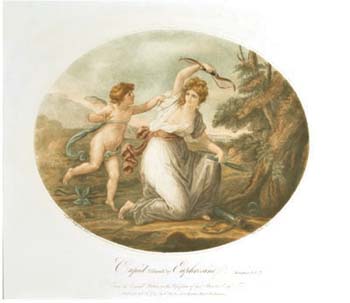Cupid Disarm'd by Euphrosine. Mestastasio, Vol. 7
- 1784
- After Angelica Kauffmann (Swiss 1741-1807) by Thomas Burke (Irish 1749-1815)
- Stipple etching
35.4 x 39.0 cm., 13-15/16 x 15-3/8" sheet
- Lent Courtesy of Private Collection through Catherine Carter Goebel, Paul A. Anderson Chair in the Arts

Essay by Kirsten Day, Associate Professor of Classics
Swiss painter and etcher Angelica Kauffmann was a major Rococo/Neoclassical artist who achieved remarkable success for a female artist of her time. She was accepted into the Accademia de S. Luca in Rome at the young age of twenty-three; she was one of two female founding members of the British Royal Academy in 1768; and she garnered the patronage and support of international royalty, including the family of Britain's George III, Russia's Grand-Duke Paul and Prince Nikolay Yusupov, Poland's Stanislav II Poniatowski and Stanislav Kostka Potocki, Naples' Queen Caroline, and Austria's Emperor Joseph II (Grove Art Online). As a Classicist with an interest in Women's and Gender Studies, I was initially drawn to Kauffmann's work because of her use of Classical themes. In researching her life and work further, however, I was intrigued at more pervasive connections with the Classical world as well.
While the appearance of Classical subject matter in art of the 18th-century Neoclassical period is not unusual, it was unusual for a woman of the time to specialize in subject pictures because of the prejudice against women studying anatomy (ibid.). Nonetheless, by her mid-twenties, Kauffmann became determined not to confine herself to the portraiture more accepted for women artists and she began to study Classical sculpture. Today, Kauffmann is best known for the small Neoclassical scenes she subsequently produced and which were disseminated through engravings. The two works featured here, Cupid Binding Agalia to a Laurel (41B) and Cupid Disarmed by Eiphrosine (41A) are typical, focusing on scenes including the god of love and two of the three Kharites, or Graces. In addition to mythological subjects like these, Kauffmann also drew from literature, as with her Hector and Andromache and Penelope at her Loom, and history, as with Cleopatra Adorning the Tomb of Marc Antony and Virgil Reading the "Aeneid" to Augustus and Octavia. While she continued to earn most of her income from portraiture, she incorporated her interest in history paintings by overlaying them with Classical allegories: for instance, in her Marchioness Townshend and her Son, the subjects are portrayed as Venus and Cupid, and her Frances Hoare includes a sacrificial offering to a statue of Minerva (ibid.).
There has been, in addition, suggestion that Kauffmann's interest in Classical subjects stemmed from more personal connections: in an article on Kauffmann's 1775 Sappho (Burlington Magazine Vol. 113 no. 818: May 1971), Peter A. Tomory notes "considerable similarities in the shape of the head, the mouth in particular and the eyes" between the image of Sappho in this piece and in Kauffmann's two self-portraits (275). As a pioneering female artist of her day, Sappho might well have had a particular appeal to Kauffmann, who in addition, as Tomory points out, includes in this painting lines from Sappho's Ode to Aphrodite, in which the poetess is "sorely troubled" due to problems with love, much as Kauffmann herself would have been around the time of its production (275). Others have likewise suggested that in a broader sense, Kauffmann's heroines represent the artist herself in a similarly personal way (Fuseli noted in Tomory 1971.275). Kauffmann's connections to the Classical world are also reflected in her connections to Rome, where she spent much of her career, and where her final tribute was paid with a triumphal procession of two of her works, emulating the funeral of Raphael, but also a clear nod to the Classical tradition.
